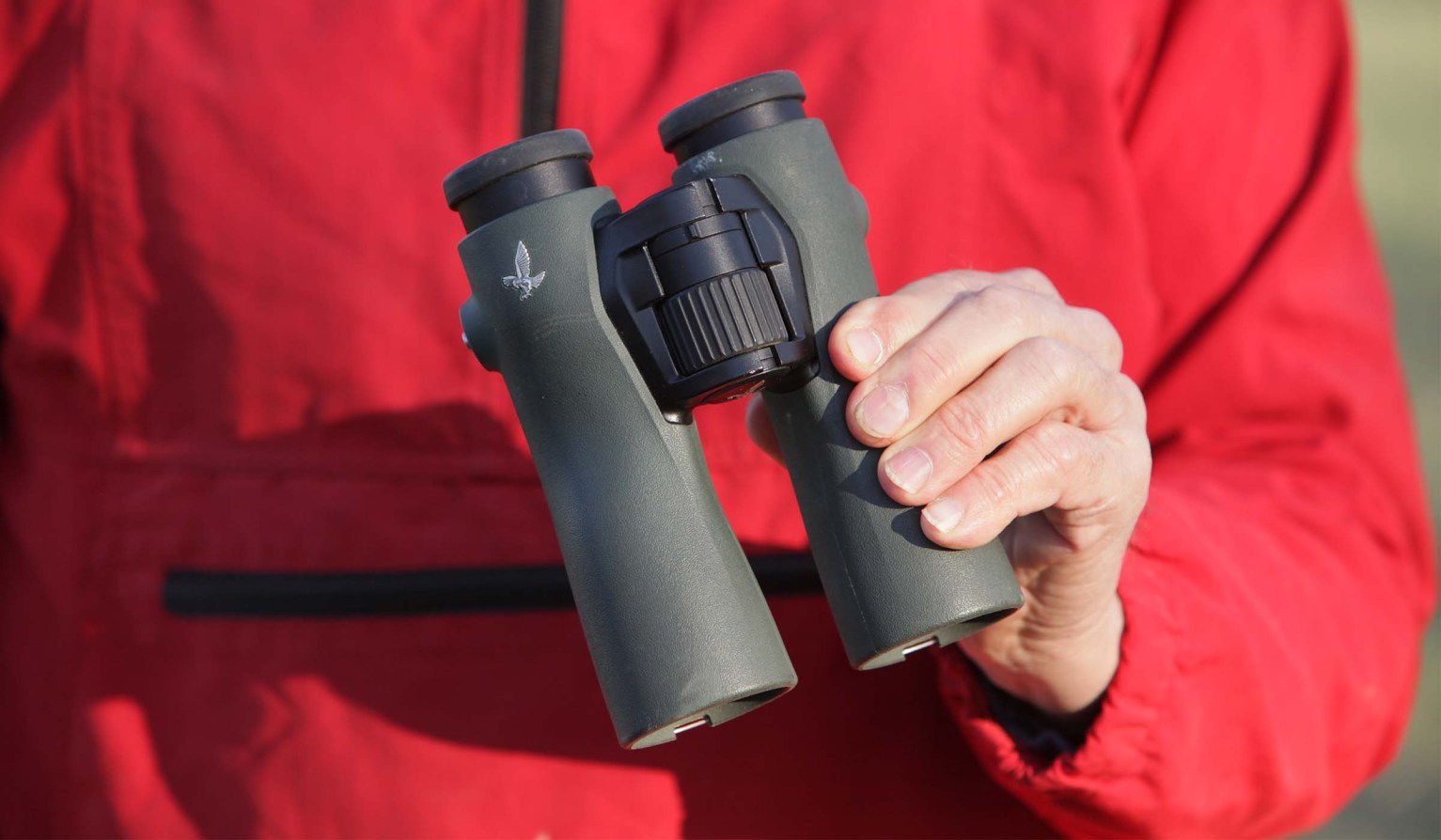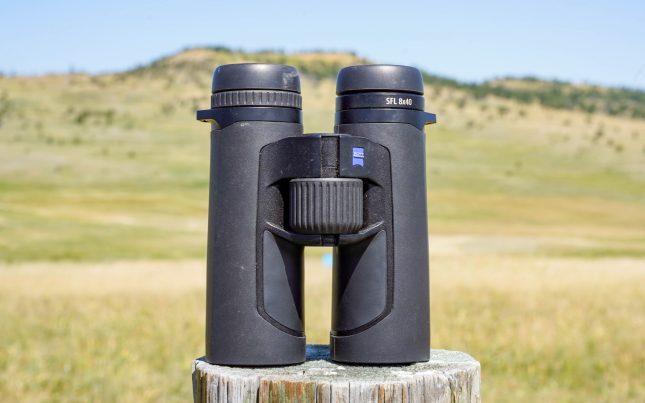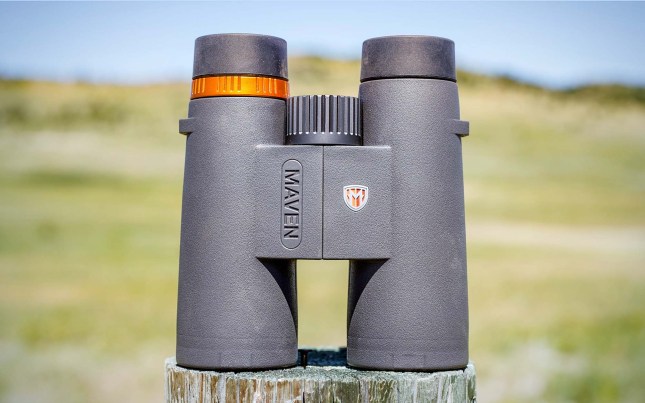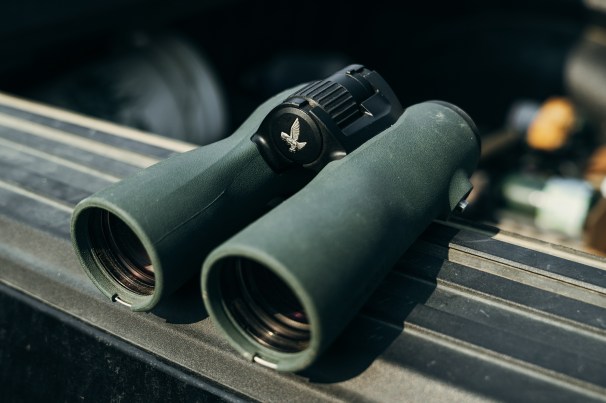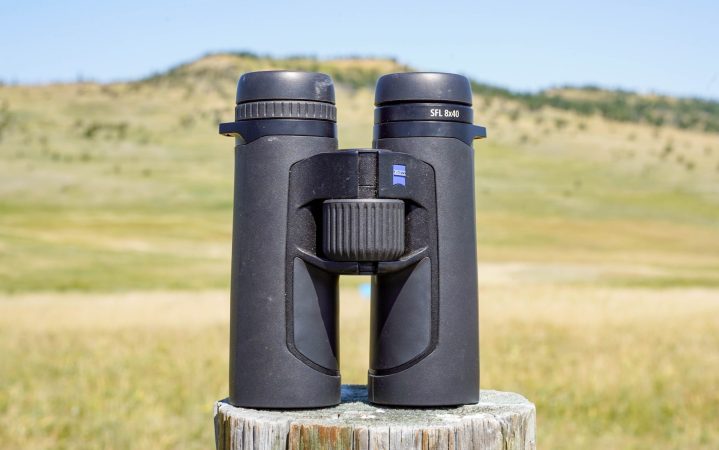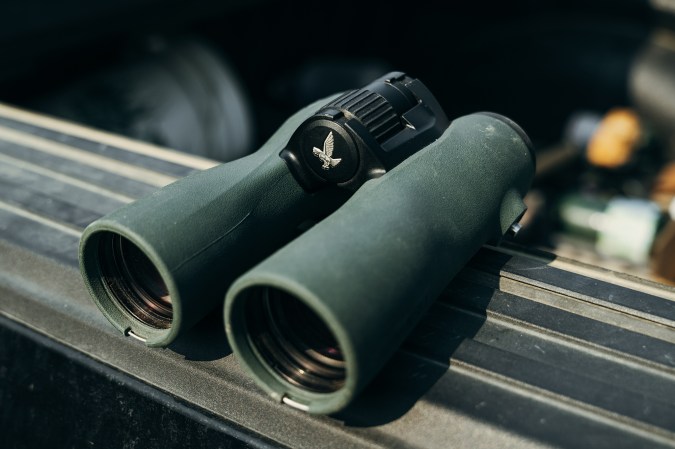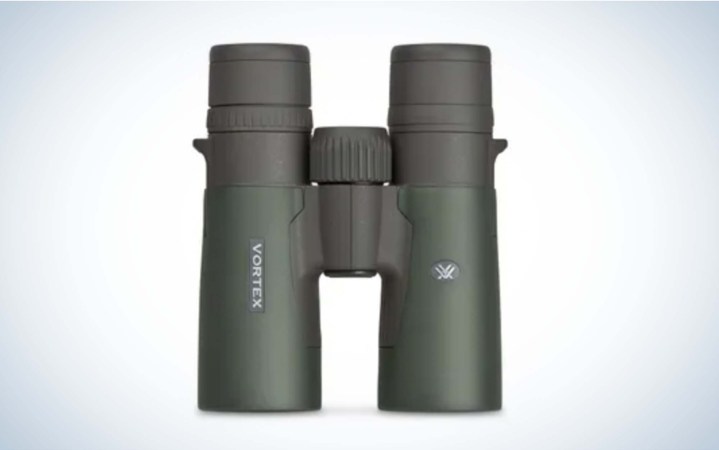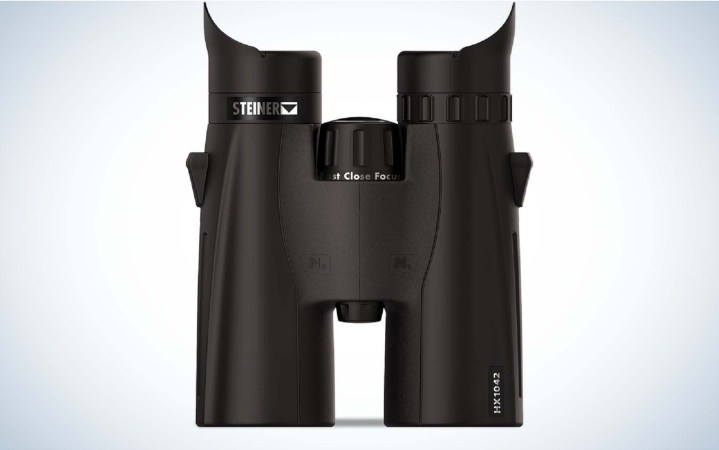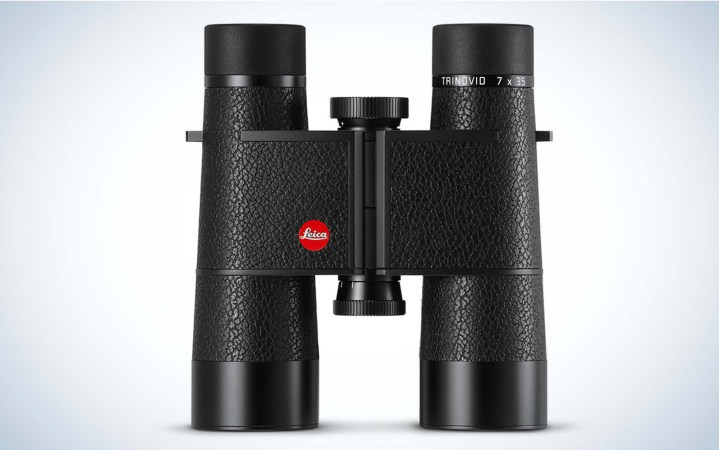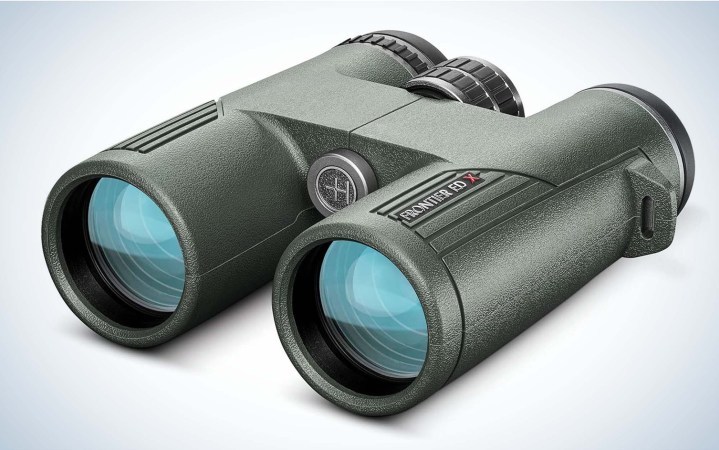We may earn revenue from the products available on this page and participate in affiliate programs. Learn More ›
Serious bird-watchers, whose hard-earned life lists and ability to quickly and accurately identify specific species give them standing in the birding community, don’t suffer sub-standard binoculars. They require optical clarity, peripheral crispness, precise focusing, and overall durability of their binoculars for bird watching. After all, the spot of a lifetime might come at last light, when you’re facing directly into the sun, or after a long, eye-straining day, and that’s when a premium pair of binoculars will make a difference.
We tested the best bird watching binoculars in the field and with resolution testing to help serious birders and new enthusiasts find their next optic. Here are our picks.
- Editor’s Choice: Zeiss SFL 8×40
- Best Value: Maven C.1 8×42
- Best Premium: Swarovski NL Pure 12×42
- Best for $1,000: Vortex Razor HD 8×42
- Steiner HX 10×42
- Best Classic: Leica Trinovid 7×35
- Hawke Frontier ED-X 10×42
How We Tested the Best Binoculars for Bird Watching

Our test is divided into field evaluations and measurable objective assessments. For the field test, we gave the binoculars to a group of experienced birders as they participated in the annual Audubon Nebraska Crane Festival in Kearney, Nebraska. The birders used the optics to view thousands of sandhill cranes along with millions of snow geese and other migrating waterfowl. The crew also participated in a prairie chicken lek viewing that took place in the feeble light of dawn and at relatively close distances.
Once the binoculars for bird watching were returned, we put submissions through the same criteria we use in Outdoor Life’s annual optics test where we decide on the best binoculars of the year. First, we measure optical resolution, using the diminishing black-and-white lines of a 1951 Air Force Resolution Target to score the optical performance of each submission. We also measure the low-light performance of each binocular by mounting them to tripods and focusing them as a group at 200 yards at a black-and-white resolution target at twilight, all in order to measure the brightness of the glass, an important consideration for birders looking for crepuscular species.
We break our 10-point scoring into four general categories: optical performance, mechanical performance, design, and value. The average of these categories is the basis of our grades, detailed below.
Optical performance includes the resolution and low-light tests plus the more subjective assessments of image quality and brightness. Mechanical performance assesses the durability of the submission along with its controls: focus and diopter controls, eyecup extension and comfort. Design considers the exterior finish, interior blacking, tripod mount, and its innovation and versatility along with its comfort. We ask testers to evaluate this critical question: How long could you glass with this binocular? And, for the specific use of viewing birds, we ask testers to consider their attributes for birding, including ease of deployment, focus, field of view, and durability in a variety of conditions.
And then our price/value score rates how much optic — along with warranty and amenities such as carrying case or harness — you get for your money.
Grading Bird Watching Optics
Our 10-point evaluation adds up to a total numeric score, but we translate those to grades for each binocular. The optical performance grade combines the scores from resolution, low-light, image, and brightness. Our mechanical performance grade aggregates the mechanics and durability score. The design grade considers construction, innovation, versatility, and comfort. And then the price grade is our value grade.
To earn an excellent grade, the average of that category must be 9 or higher, which is extremely hard to achieve. Very good is an average score of 7 to 9. A good grade is 5 to 7. Our fair grade is 3 to 25, and poor is anything under 3.
Best Binoculars for Bird Watching: Reviews & Recommendations
Editor’s Choice: Zeiss SFL 8×40
Score Card
- Optical Performance: Very good
- Mechanical Performance: Excellent
- Design: Excellent
- Price/Value: Very good
Key Features
- Field of View at 1,000 yards: 420 feet
- Weight: 22.6 ounces
- Double-hinge, open-barrel design
- Right-barrel diopter control
- Oversized focus wheel
- Also available in 10×40, 8×30, and 10×30 models
- Price: $1,800
Pros
- SmartFocus wheel zooms from close focus to infinity in 1.4 turns
- DoubleLink bridge enables good barrel grip
- Premium glass and coatings
- Excellent 4.9-foot close focus
Cons
- Some users wanted slightly more heft
- Straps and case are fairly pedestrian
Zeiss brings two very appealing value propositions to this handy binocular that’s purpose-built for birders. First is its extremely light weight. The 1.5-pound build makes them the lightest premium binocular for bird watching on the market, and the weight is further lifted when the optic is deployed with a bouncy neoprene neck strap.
To put a fine point on the design, it’s intended to appeal to frailing birders who are looking for alternatives to the heft of premium optics, but who still demand best-in-glass glass.
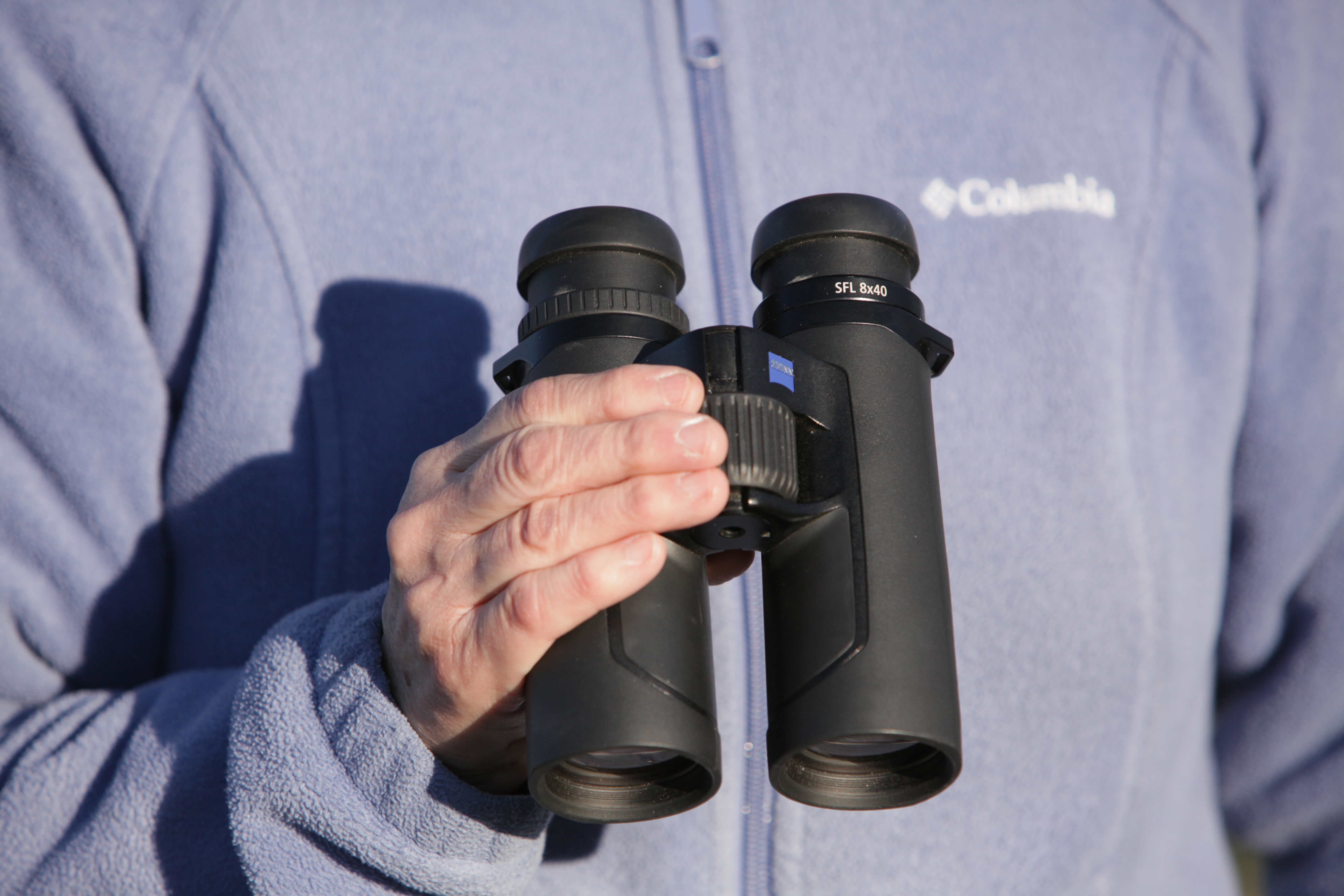
Andrew McKean
The second attribute is the oversized focus wheel, which can riff from an extremely tight close focus of 4.9 feet out to infinity in just 1.4 rotations of the wheel. That’s a huge asset for birders, who use their optics to pick apart various distances, and who often are drilling in on small birds in tight cover one moment and then extending their reach to view distant birds on the wing the next. The focus wheel, sized to be used with smaller hands, moves as though it rides on ball-bearing tracks, so smooth and fluid is its travel.
The Zeiss SFL — the name stands for SmartFocusLightweight — is one of the most ergonomic binoculars in the field, its balance and grip enhanced by its open-bridge design. Its weight and open-barrel design make single-hand operation easy, and testers had high praise for the binocular’s tapered eyecups that are unexpectedly comfortable to use for extended periods.
The $1,500 SFL scored near the top of the field on our price/value consideration. You’ll pay north of $3,000 for Swarovski’s excellent NL Pure or for Leica’s stunning Noctovid. Zeiss, too, asks $3,000 for its marvelous Victory SF binocular. So to find a binocular for bird watching that performs nearly on par with those flagship models for half the price is worth talking about.
Zeiss saves some money on its SFL model by importing this model from Japan; most of its premium optics are made in either Germany or Portugal. And it has found some additional savings in glass by using thinner lenses than it uses in its SF line. Those slimmer, more precisely ground lenses also allow the SFL to shave nearly half a pound from the SF in the same configuration.
But the image delivered by those halfling lenses is nearly as sharp and vibrant as those of Zeiss’s other premium binoculars. The SFL posted one of the top resolution scores at this year’s optics test, and testers raved about the vibrant image with rich contrast and stunning colors. It lost points on disappointing low-light performance, which was partly due to its diminutive 8×40 configuration.
The reason the SFL is here in the top spot as a birding binocular is its field-worthy operation. Its focus is fine and precise, the wide field of view (420 feet at 1,000 yards) takes in an immense panorama, and its glass is very good, though we must say not quite as good as that in Swarovski’s NL Pure. Users found that they could glass all day behind the Zeiss, which is an important asset on destination birding trips, when you want to maximize your time sighting, identifying, and recording birds.
A couple testers wanted a bit more magnification from the Zeiss. Happily, there are SFLs in these configurations: 10×40, 8×30, and 10×30.
Read Next: Swarovski AX Visio: The Most Advanced, and Controversial, Birding Binocular
Best Value: Maven C.1 8×42
Score Card
- Optical Performance: Very good
- Mechanical Performance: Good
- Design: Very good
- Price/Value: Excellent
Key Features
- Field of View at 1,000 yards: 341 feet
- Weight: 24.5 ounces
- Closed-bridge design
- Polymer chassis
- Extra-low dispersion ED glass
- Three-position eyecups
- Right-barrel diopter control
- Price: $400
Pros
- Very affordable
- Distinctive orange accents on black frame
- Ships with handy nylon case and strap
- Excellent 5.9-foot close focus
Cons
- Good glass, but not “wow” glass
- Square hand feel
Consider this an every person birding binocular. Priced accessibly at $400, the 8×42 version of the C.1 gets pretty much everybody in the game with a durable optic that contains good glass and responsive controls.
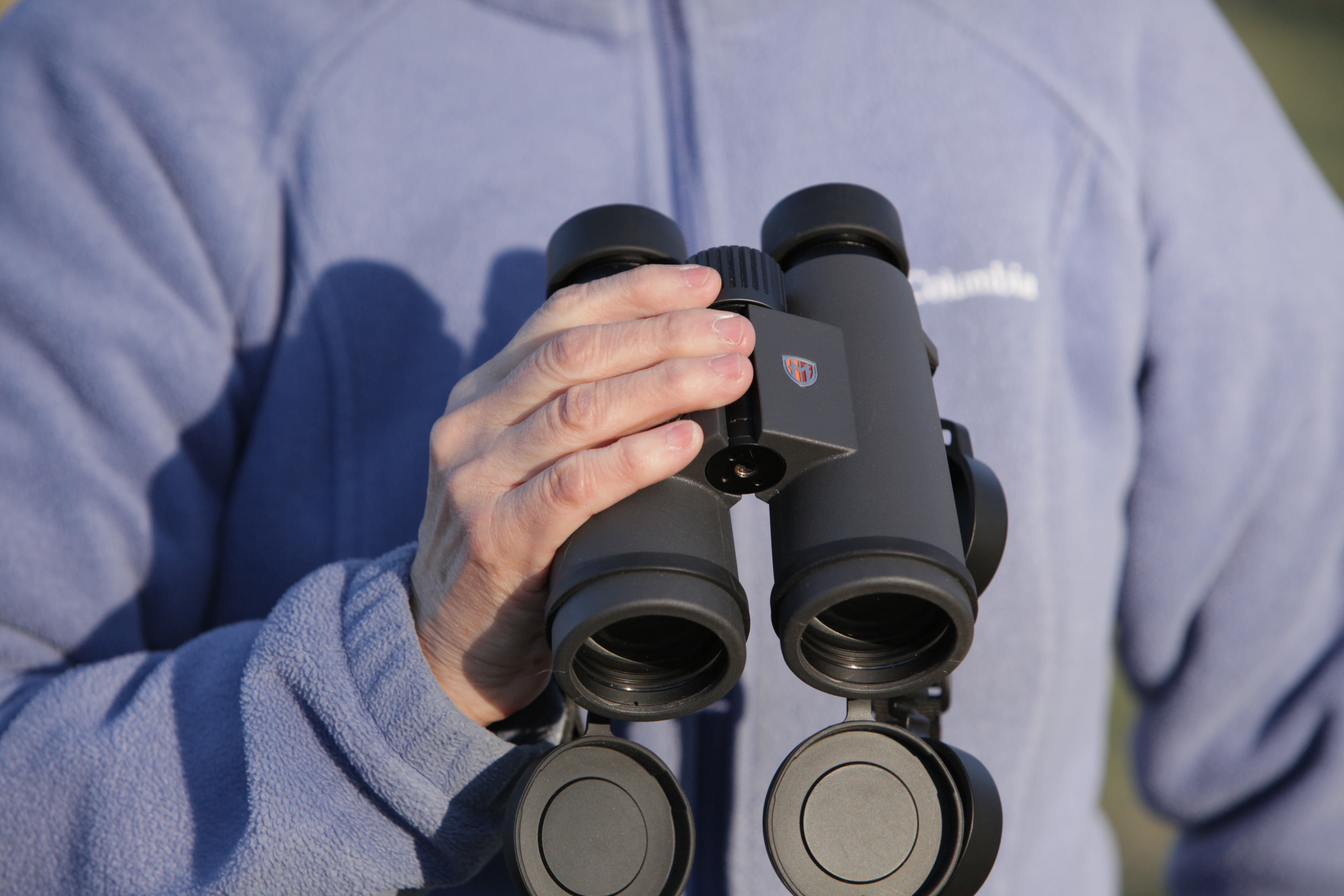
Andrew McKean
It’s a little unfair to compare this good binocular with some of the premium optics on the market, in the shape of the Zeiss, Leica, and Swarovski. But it’s also unfair to the Maven to call it an entry-level binocular for bird watching. The C.1 is better than you’d expect, given its accessible price.
The heart of the C.1, which represents the brand’s mid-level optic, is very good extra-low dispersion glass in the objective lenses and decent glass elsewhere. Coatings and overall handling are very good, and testers especially like the highly textured oversized focus wheel that riffs from close focus (5.9 feet) to infinity with about two revolutions.
But the test team was divided on the handling of the C.1. Some like the heft and square build of the binocular, but others thought the eyecups are too square to fit many eye sockets, and the angular frame didn’t easily slip into and out of binocular harnesses. If the 8×42 version isn’t quite for you, Maven offers the C.1 in 10×42 ($425) and 12×42 ($450).
Best Premium: Swarovski NL Pure 12×42
Score Card
- Optical Performance: Excellent
- Mechanical Performance: Very good
- Design: Excellent
- Price/Value: Good
Key Features
- Field of View at 1,000 yards: 339 feet
- Weight: 29.5 ounces
- Fluorite glass
- Magnesium-alloy chassis
- Short closed-bridge design
- Field-flattener lens system
- Price: $3,549
Pros
- Curved barrels hug hands, minimizing shake
- Extremely positive focus wheel
- Tapered three-position eyecups
- Long eye relief
Cons
- Wildly expensive
Swarovski’s NL Pure might well be the best binocular for bird watching if price isn’t a concern. The wasp-bodied curves of its shapely barrels grip your hands, creating a rock-solid support for glassing with even the 12-power model. The field-flattener lenses create a picture-window view of the world. And the immense field of view — among the widest in the business — gives birders a lot to look at.
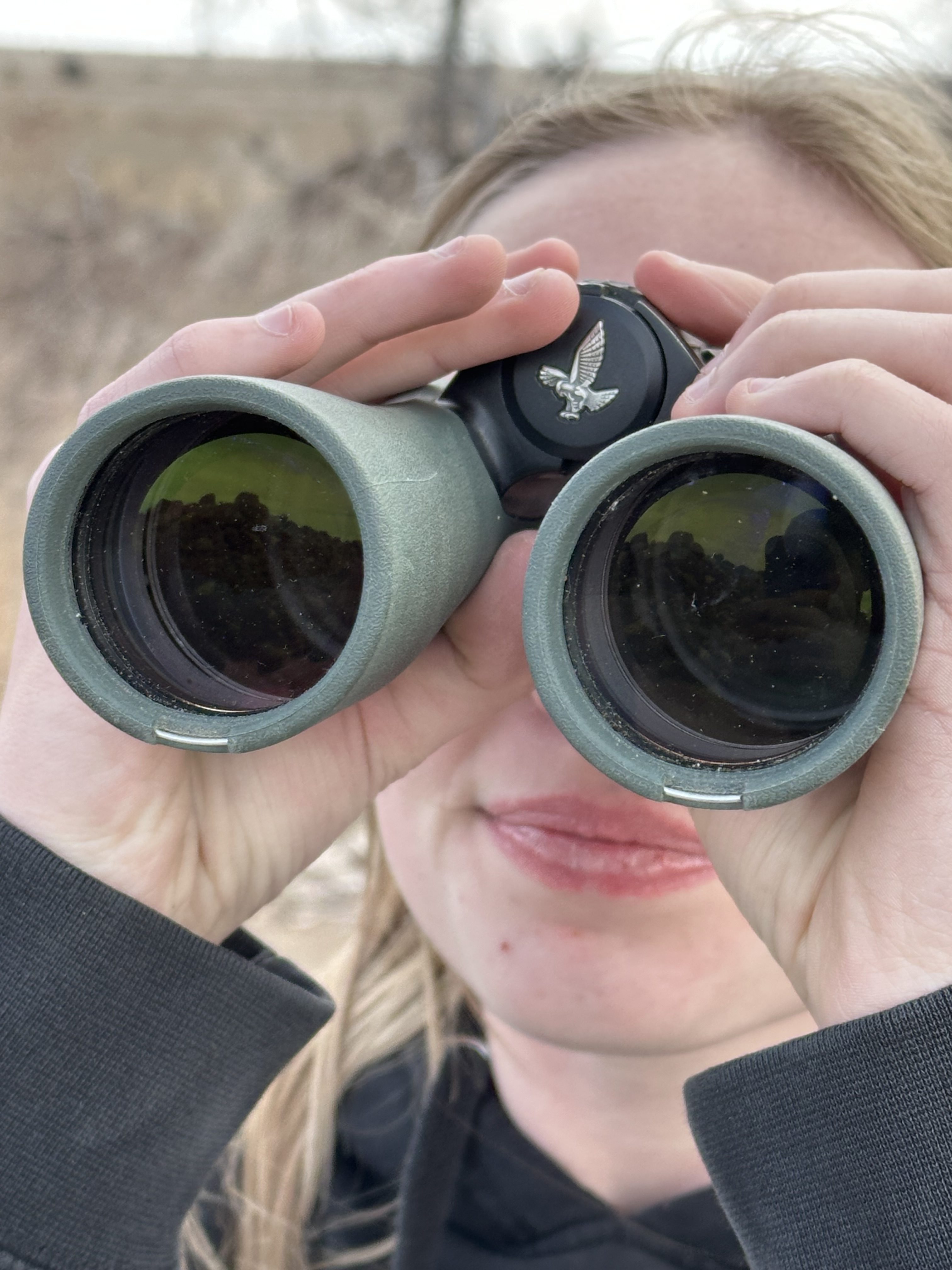
Andrew McKean
As might be expected, Swarovski brings its best class of glass — a fluorite recipe that tames aberrant light and intensifies colors and depth — to the NL Pure. But if the stunning image gets your attention, the mannerly controls keep you glassing. The oversized focus wheel turns with precision, and the eyecups fit most brows comfortably. In short, it’s a joy to use for extended periods, which is one of the best things you can say of a binocular at any price.
But our testers reported two shortcomings. First is the magnification. The only evaluation model we had, a 12-power, was a bit too powerful for our testers, who said either 8- or 10-power models are better for their style of birding, which puts a premium on hiking, then using a wide field of view to take in panoramic sweeps of terrain and vegetation.
“The 12-power was a bit much to quickly find and focus close-up objects,” noted tester Woody Baxter.
Testers also noted that it’s not easy to mount the NL Pure to a tripod, though they appreciated the availability of Swarovski’s optional forehead rest that supposedly reduces hand-induced shake for extended glassing sessions.
It should be noted that the NL Pure comes in a configuration to suit just about any need or preference, from 8×32 to 8×42, 10×32, and 10×42 in addition to our 12×42 version.
Our testers aren’t particularly dissuaded by the high price of premium binoculars, but they noted that the $3,549 retail for the 12×42 Swaros is pretty stratospheric. That detail alone kept the otherwise excellent NL Pure from grabbing the best birding binocular accolade.
Best for $1,000: Vortex Razor HD 8×42
Score Card
- Optical Performance: Excellent
- Mechanical Performance: Very good
- Design: Excellent
- Price/Value: Very good
Key Features
- Field of View at 1,000 yards: 388 feet
- Weight: 24.2 ounces
- Center-hinge design
- Oversized focus wheel
- High-definition, index-matched objective lenses
- Locking right-barrel diopter control
- Front-hinge tripod adapter
- Also available in 12×50, 10×50, and 8×42 models
- Price: $1,430
Pros
- Open-barrel design enables one-hand operation
- Thin, tapered eyecups fit most faces
- Compact design for a 42mm frame
- Ships with premium GlassPac case and harness
Cons
- At $1,429 retail, fairly pricey
- Relatively narrow field of view
- Barrels could use more texturing
This eight-power version of an OL optics test crew favorite 10×42, was a top pick among the bird watching testers. This 8×42 hits the sweet spot between premium glass, a trim chassis, all-day comfort, and at around $1,000 street pricing, relative affordability for the category.
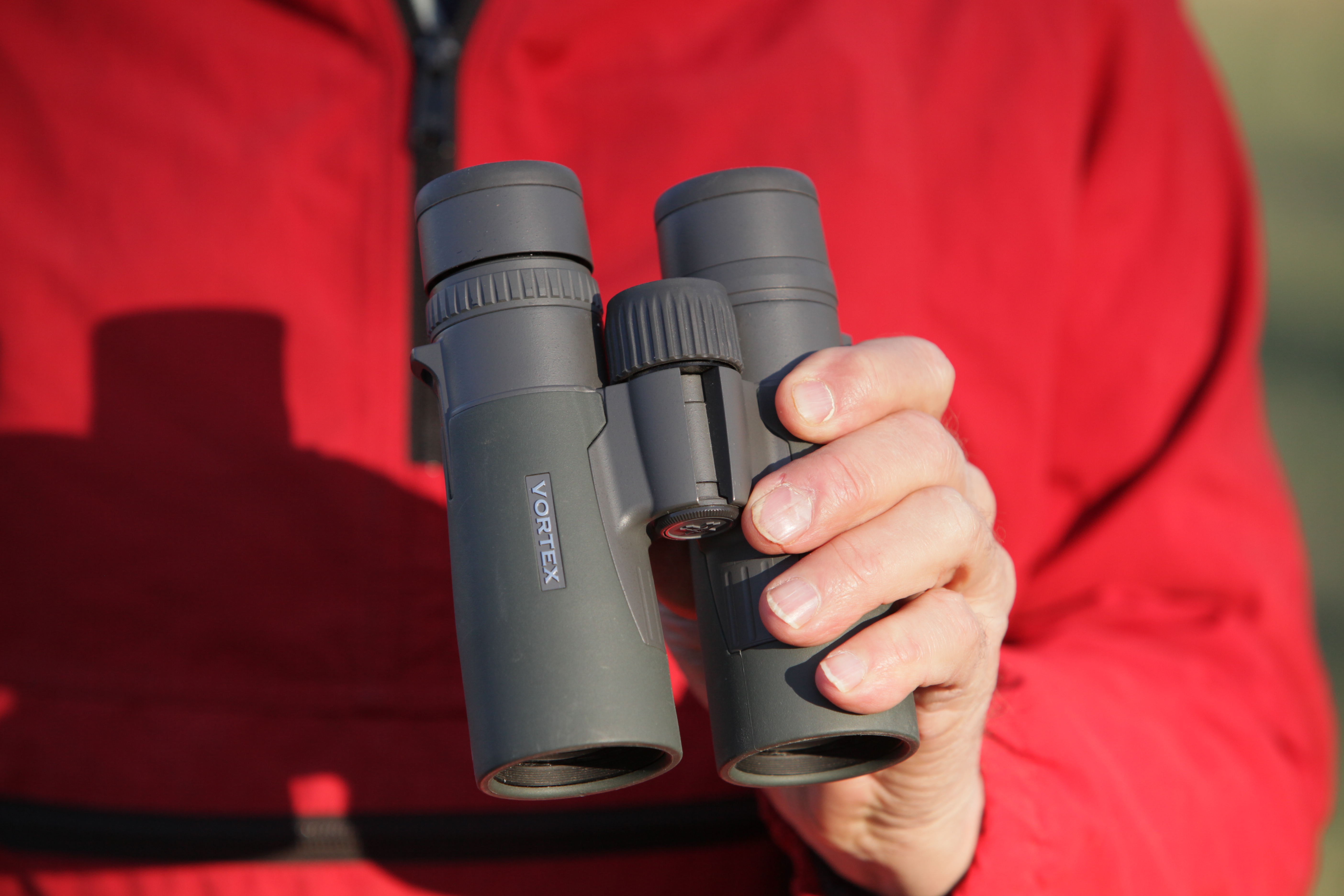
Andrew McKean
Like other models in the test — the Zeiss SFL and Swarovski NL Pure — the Vortex has big, grippy barrels and an oversized focus wheel that’s easy to deploy with a single hand and which ramps between close focus (6 feet) and infinity. The eyecups are thin and tapered to fit smaller faces, and the pull-to-turn locking diopter control is one of the best and most fluid of all submissions.
The class of glass that Vortex uses in this Japan-made binocular is very good. It’s one of the best examples of what the industry calls HD, or high-definition, glass. That’s a relatively meaningless term, but Vortex claims to index-match the lenses in order to balance their performance, and the coatings further boost color fidelity and contrast.
Our birding evaluators were a little more critical of the $1,000 price tag than our past optics testers have been.
“Just for the heck of it, I compared the Razor HD to my [Vortex] Diamondback HD, both in 8×42, and at close distances, the Razor had slightly more clarity but at farther distances they seemed equal during most light conditions,” reported tester Woody Baxter. The Diamondback is a step down in Vortex’s line in price and components. “Where the Razor HD was better was its controls, from its focus to its hinge tightness and its eyecups, and the Razor was noticeably brighter in low-light conditions,” as might be expected with its higher-level glass.
Vortex softens the $1,000 hit by including a premium GlassPak binocular case and harness with the Razor HD. And the company’s legendary fully transferable lifetime warranty further makes the case for the Vortex not only as a capable companion on the birding trail, but as a good investment.
Steiner HX 10×42
Score Card
- Optical Performance: Very good
- Mechanical Performance: Very good
- Design: Good
- Price/Value: Fair
Key Features
- Field of View at 1,000 yards: 326 feet
- Weight: 28 ounces
- Fast-Close-Focus focus wheel
- Makrolon polycarbonate chassis
- ClicLoc neck strap and objective lens cover attachments
- Left-barrel diopter control
- Price: $1,149
Pros
- Thick and durable rubber armor
- Front threaded tripod adapter
- 6-foot close focus
Cons
- At 28 ounces, relatively heavy
- At $1,149 retail, relatively pricey
This very capable Steiner surprised the test team. The German brand has been designing its optics with what might be called Euro-tactical styling in the last few years. The HX, true to that design direction, looks like a B1 bomber, with swooping lines and a futuristic profile.
But inside that edge (and polycarbonate) chassis is a very good binocular for bird watching, with high-definition glass and excellent contrast-boosting coatings. One design element that hasn’t changed over the last two decades is Steiner’s distinctive bat-wing eyecups. Our annual optics test team tends to roll its collective eyes over this feature, which we find gets in the way, and even when rolled down tends to pop back up at inopportune times. But our panel of birders absolutely loved this feature.
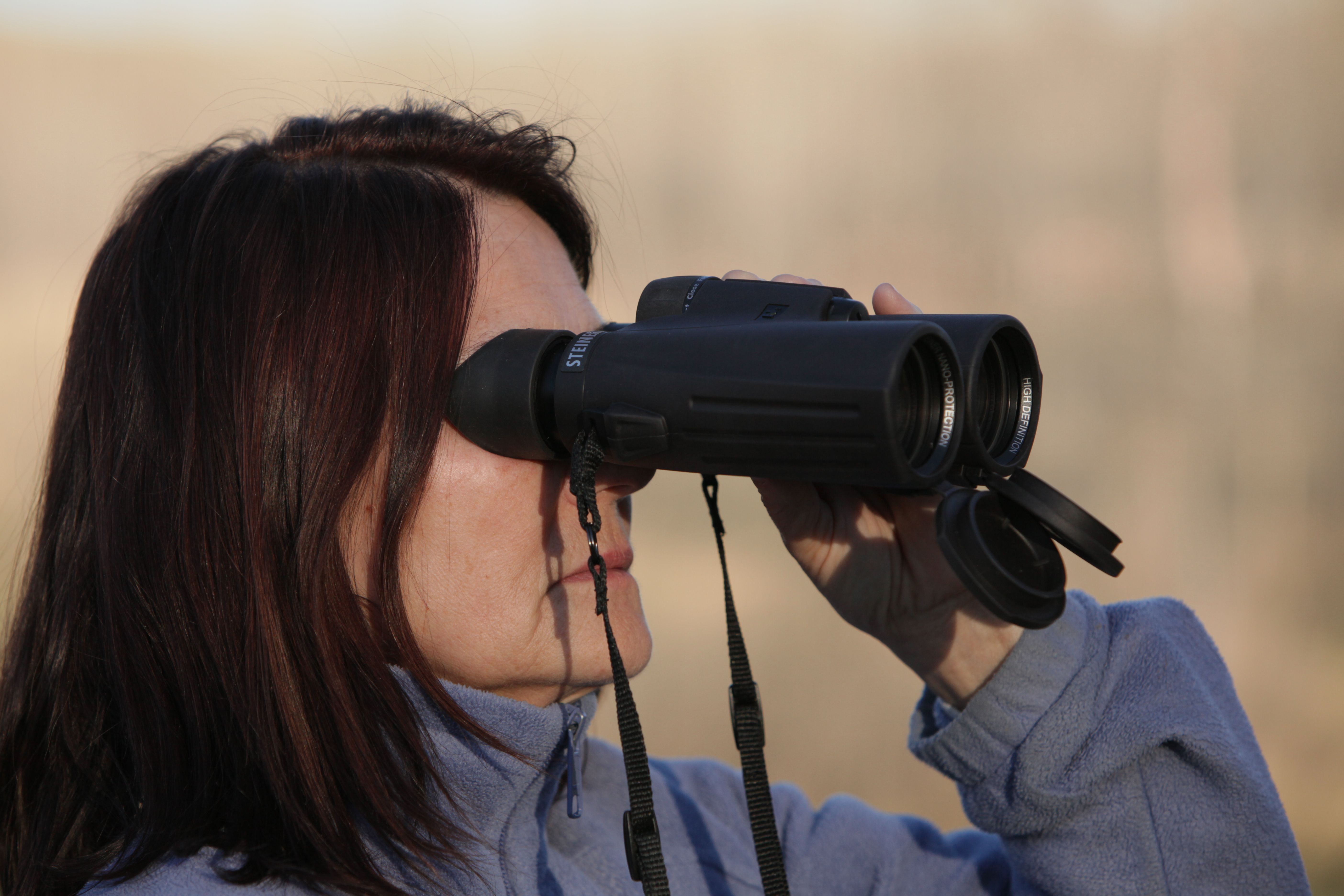
Andrew McKean
“The eyecups allowed my eyes to relax, because they effectively block peripheral light,” noted tester Terry Divoky. Fellow tester Woody Baxter offered that the eyecups posed no issue, but he did struggle with the floppy lens covers. Happily, the covers, which connect to the chassis through an innovative “Clic-Loc” connection, can be removed.
Baxter noted that the HX bridge was a bit narrow for his large nose.
“I graded down on comfortability because the binocular didn’t really fit my face,” he noted.
But optical resolution and low-light performance were both in the upper half of the loaded field, and testers liked the precision of the controls. Weight is a little heavy; at 28 ounces it’s one of the heavier 10×42 models in the test, but testers liked the 6-foot close focus and decent field of view.
The HX ships with a premium zippered case, neoprene strap, and is covered by Steiner’s Heritage Warranty, which is fully transferable and valid for the lifetime of the product.
Best Classic: Leica Trinovid 7×35
Score Card
- Optical Performance: Excellent
- Mechanical Performance: Very good
- Design: Excellent
- Price/Value: Good
Key Features
- Field of View at 1,000 Yards: 460 feet
- Weight: 20.8 ounces
- Aluminum chassis
- Four-position eyecups
- Center-hinge diopter control
- Price: $1,499
Pros
- Vintage look, modern glass
- Textured leather armor
- Versatile configuration
- Innovative pull-to-lock three-position eyecups
- Best-looking binocular in our collection
Cons
- Disappointing close focus (13 feet)
- Not tripod-adaptable
- At around $1,500, pricey
Externally, this appears to be a throwback optic, one that dates from the high style of post-war Europe. Its leather armor is tasteful and talented, in that it easily holds even wet hands. Its classic lines could win design awards for tasteful, functional excellence. Like the little black dress of some fashion mavens, this binocular goes everywhere and goes with everything.

Andrew McKean
But you’d be wrong to judge the Leica Trinovid only on its appearance. Under that elegant exterior and shapely aluminum chassis is Leica’s excellent glass that makes images vibrant, and coatings that protect this investment from the elements. Make no mistake, it is an investment. At nearly $1,500, it’s an expensive binocular, especially in the unusual 7×35 configuration.
We sent the Trinovid to Nebraska with our birding-trail evaluators, and they returned with mixed opinions.
“I found the size too small for my hands. It was hard to grasp and a little uncomfortable,” notes tester Woody Baxter, who prefers eight-power or 10-power binoculars for his birding purposes. “The eyecups were especially uncomfortable.”
But tester Terry Divoky said the seven-power magnification wasn’t a turn-off. Instead, she noted that the light weight (20.8 ounces) of the Leica didn’t settle in her hand.
All our birding contributors thought the best use of the Leica is as a travel binocular that they could deploy on impromptu birding opportunities. They gave it high marks on its design, portability, versatility, and overall styling.
Hawke Frontier ED-X 10×42
Score Card
- Optical Performance: Very good
- Mechanical Performance: Very good
- Design: Good
- Price/Value: Very good
Key Features
- Field of View at 1,000 yards: 336 feet
- Weight: 25.6 ounces
- Textured center-hinge focus wheel
- Close focus: 8.2 feet
- Right-barrel diopter control
- Closed-bridge design
- Ships with premium zippered case
- Price: $549
Pros
- Durable magnesium-alloy chassis
- Front-hinge threaded tripod adapter
- Tapered eyecups
- Extra-low dispersion glass
Cons
- Relatively heavy
- Underwhelming low-light performance
- Some yellow color fringing
Like the Maven C.1, this is what can be considered a gateway binocular for bird watching, a competent, durable, and entirely serviceable optic that has good field talents but which — maybe more importantly — costs a fraction of premium European binoculars.
It’s hard to distinguish differences between both ends of the optical-performance spectrum during most light conditions. When the sun is out and viewing conditions are favorable, most binoculars will deliver positive bird IDs and bright images. It’s when the sun sets, cloud cover obscures details, and birds start to move that the premium glass and high-tech coatings shine.
With that recognition, the Hawke Frontier ED-X will meet or exceed most users’ expectations. The handling is crisp and precise. The glass is good enough. And the durability is excellent, meaning you can take the Hawke anywhere. The price, about $500 real-world street price, makes this an accessible option for birders looking for a binocular that will keep up with premium optics for a fraction of the price.
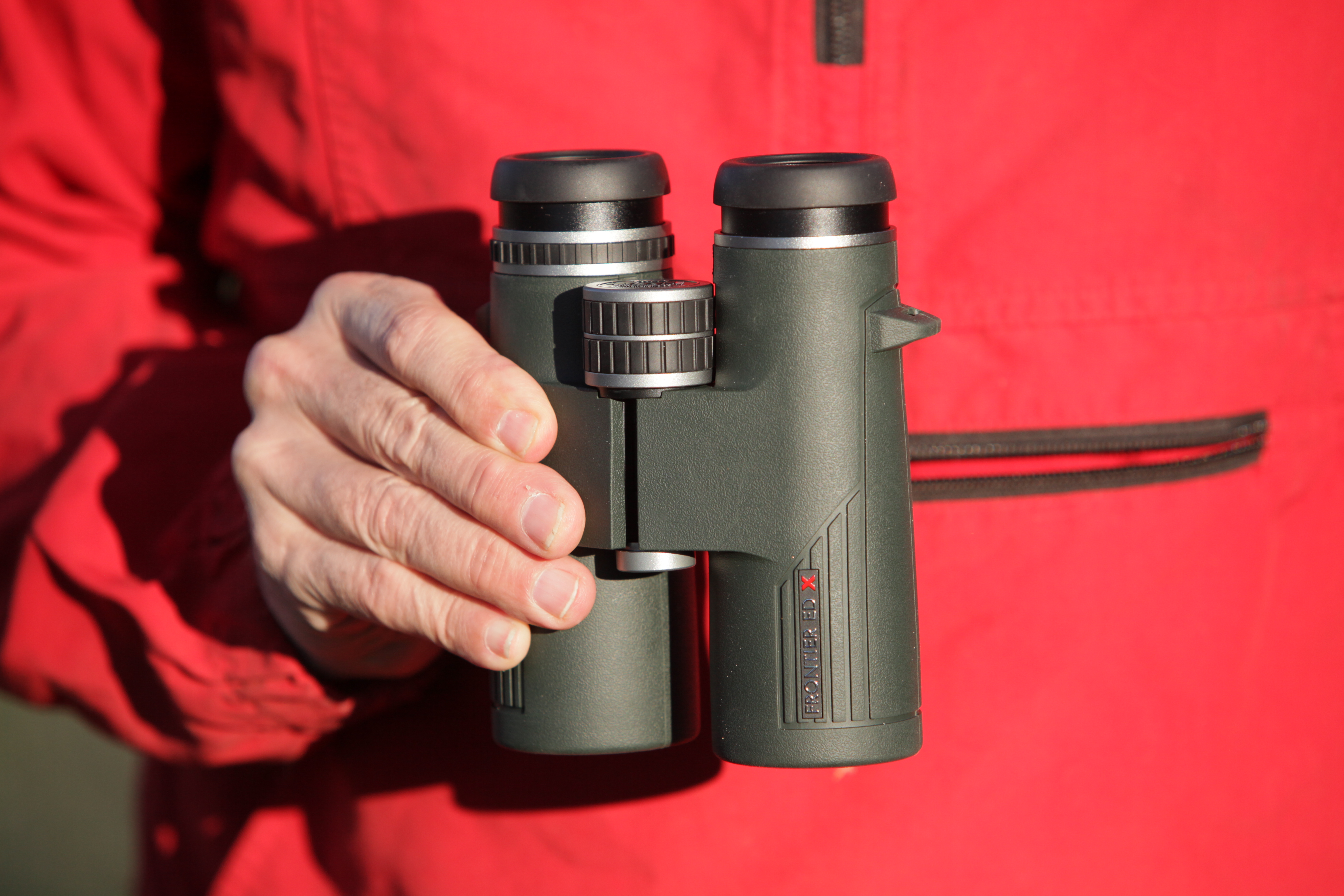
Andrew McKean
In Nebraska’s birding festival, testers noted that its handling — focus control and diopter precision — were both excellent, and the tapered chassis was comfortable. The weight – 25.6 ounces – tended to make the Hawke a bit heavy after extended glassing sessions.
“I was unfamiliar with Hawke as a brand, but the Frontier’s premium case, good-looking lines, and overall optical performance made me a convert,” said one tester. “It’s a very good option for birders who want to get into the field but who don’t have the funds for one of the super-premium brands.”
How to Choose the Best Birding Binocular
There are so many crossovers between the optical demands of deer hunters and birders that both groups should recognize their similarities, and even take guidance from each other. Since that’s unlikely to happen, let us do that work for you. Both groups value optical talent, from crisp and bright images to precise focus to bombproof durability. And both communities are looking for that magical confluence of performance and value.
Ultimately, there’s very little difference between a premium binocular for bird watching and a premium binocular for other uses, but there are some important considerations if you’re a birder. First, you want to look for optics that deliver excellent optical performance in a lightweight package. That’s because birders cover a lot of ground in the course of a productive birding day. And you want a package that can handle rain, fog, cold weather, but also all the abuses of the field. In that way, hunters and birders have very congruent expectations of their optics.
For those with $1,500 or more to spend on a birding binocular, consider the glass, handling, and warranty of prospective purchases. For those with $500 to spend, the warranty and versatility of the optic is more important; how suitable is your birding binocular to hunting, glassing backyard wildlife, and traveling?
Also consider the configuration. Many birders swear by eight-power optics. That gives them the best combination of field-of-view, magnification, and optical brightness. But don’t dismiss 10-powers for their birding talents. Many appreciate the magnification for identifying birds in the middle to longer distances, or for teasing out birds from tight cover.
Lastly, consider the warranty. Most optics brands offer fully transferable lifetime warranties, and given all the warps and wefts of the birding trail, you may very well need to redeem the warranty at some point, so weigh the warranty as one of the value-propositions of any prospective birding bino.
Final Thoughts on the Best Binoculars for Bird Watching
Binoculars for bird watching are the instrument that contributes more to birding success than any other. That’s why we’re willing to invest in optics more than any other item of gear. If you’re just getting started in bird watching, our best value pick is an excellent place to start. If you’re further along in your birding journey, consider our editor’s choice pick or the indulgently awesome Swarovski.
- Editor’s Choice: Zeiss SFL 8×40
- Best Value: Maven C.1 8×42
- Best Premium: Swarovski NL Pure 12×42
- Best for $1,000: Vortex Razor HD 8×42
- Steiner HX 10×42
- Best Classic: Leica Trinovid 7×35
- Hawke Frontier ED-X 10×42
